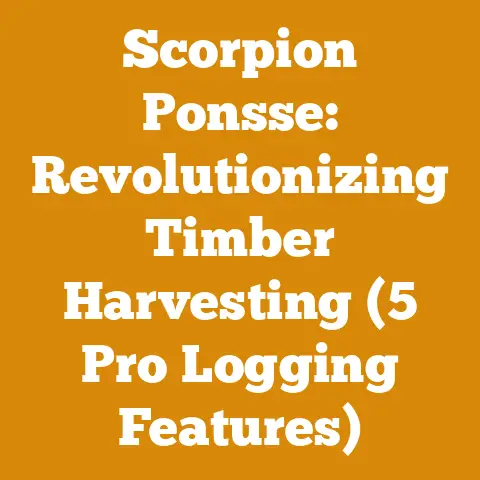Can You Prune Dogwood Trees? (5 Expert Arborist Tips)
Ah, the simple pleasure of a well-maintained landscape! There’s nothing quite like stepping out into my yard and feeling that sense of calm, knowing that everything is just as it should be. And often, that feeling starts with the trees. The question of whether you can prune dogwood trees is one I’ve heard countless times, and the answer is a resounding yes, with a few important caveats. As an arborist, I’ve spent years learning the ins and outs of tree care. So, let’s dive into the details of pruning dogwood trees, sharing some expert tips that I’ve picked up along the way.
Understanding Dogwood Trees and Their Pruning Needs
Dogwoods are a beautiful addition to any landscape, known for their stunning spring blooms and vibrant fall foliage. But like any tree, they require proper care, including pruning, to maintain their health, shape, and overall aesthetic appeal.
Why Prune Dogwood Trees?
Pruning isn’t just about aesthetics; it’s crucial for the health and longevity of your dogwood. Here’s why I find it so important:
- Removing Dead or Diseased Wood: This is perhaps the most critical reason. Dead or diseased branches can harbor pests and diseases that can spread to the rest of the tree. Removing these branches helps keep your dogwood healthy and vigorous. I once had a client whose dogwood was riddled with dogwood anthracnose, a fungal disease. By carefully pruning away the infected branches and applying a fungicide, we managed to save the tree.
- Improving Air Circulation and Sunlight Penetration: A dense canopy can restrict airflow and sunlight, creating a humid environment that encourages fungal growth. Pruning helps open up the canopy, allowing air and sunlight to penetrate, which promotes healthy growth.
- Shaping the Tree: Pruning allows you to shape the tree to your desired form. Whether you want a more rounded shape, a more open habit, or a specific silhouette, pruning can help you achieve your vision.
- Encouraging New Growth: Pruning stimulates new growth, which can lead to more abundant blooms and a fuller, healthier tree.
- Safety: Removing crossing or rubbing branches reduces the risk of branch failure, especially during storms or high winds. I’ve seen too many instances where neglected trees have caused damage to property due to weak or poorly structured branches.
When to Prune Dogwood Trees
The best time to prune dogwood trees is typically in late winter or early spring, before new growth begins. This is when the tree is dormant, and pruning will have the least impact on its overall health.
- Late Winter/Early Spring: This is the ideal time for general pruning, including removing dead, diseased, or damaged branches. It’s also a good time to shape the tree and encourage new growth.
- After Flowering: You can also prune dogwoods lightly after they finish flowering. This is a good time to remove any spent blooms or to make minor adjustments to the tree’s shape. However, avoid heavy pruning at this time, as it can reduce the number of flowers the following year.
- Avoid Fall Pruning: I generally advise against pruning dogwoods in the fall, as this can stimulate new growth that is susceptible to frost damage.
5 Expert Arborist Tips for Pruning Dogwood Trees
Now, let’s get into the specifics. Here are five expert tips that I’ve learned over the years for pruning dogwood trees:
Tip 1: Use the Right Tools
Using the right tools is essential for making clean, precise cuts that promote healing and prevent disease. Here’s what I recommend:
- Hand Pruners: For small branches (up to 1/2 inch in diameter).
- Loppers: For larger branches (up to 1 1/2 inches in diameter).
- Pruning Saw: For branches larger than 1 1/2 inches in diameter.
- Pole Pruner: For reaching high branches without using a ladder.
Tool Maintenance:
- Sharpening: Keep your tools sharp to make clean cuts. Dull tools can tear the bark and damage the tree. I use a sharpening stone to keep my pruners and saw in top condition.
- Cleaning: Clean your tools after each use to prevent the spread of disease. I use a solution of 1 part bleach to 9 parts water to disinfect my tools.
- Lubrication: Lubricate your tools regularly to keep them working smoothly. I use a light machine oil for this purpose.
Specification Table for Pruning Tools
| Tool Type | Blade Material | Handle Material | Maximum Cutting Diameter | Recommended Use |
|---|---|---|---|---|
| Hand Pruners | High Carbon Steel | Forged Aluminum | 0.75 inches | Small branches, twigs, and suckers |
| Loppers | Tempered Steel | Fiberglass | 2 inches | Larger branches within reach |
| Pruning Saw | Impulse Hardened Steel | Wood/Composite | 4 inches | Branches too thick for loppers |
| Pole Pruner | Coated Steel | Telescoping Aluminum | 1.25 inches | High branches that are difficult to reach from the ground |
Safety First: Always wear safety glasses and gloves when pruning. If you’re using a ladder, make sure it’s stable and properly positioned.
Tip 2: Make Proper Pruning Cuts
Making the right cuts is crucial for promoting healing and preventing disease. Here’s how to do it:
- Branch Collar: When removing a branch, cut just outside the branch collar, the swollen area at the base of the branch where it joins the trunk. Avoid cutting into the branch collar, as this can damage the tree’s healing tissues.
- Three-Cut Method: For larger branches, use the three-cut method to prevent tearing the bark.
- Make a shallow cut on the underside of the branch, a few inches from the branch collar.
- Make a second cut on top of the branch, a few inches further out from the first cut. This will cause the branch to break off.
- Make the final cut just outside the branch collar, removing the remaining stub.
- Angle of Cut: Angle your cuts slightly to promote water runoff and prevent rot.
Technical Specifications for Pruning Cuts:
- Branch Collar Distance: 1/4 to 1/2 inch outside the branch collar.
- Angle of Cut: 30 to 45 degrees from the branch.
- Cut Smoothness: Ensure cuts are smooth and free of jagged edges to promote callus formation.
- Sealants: Avoid using pruning sealants unless specifically recommended by an arborist for disease control. Modern research indicates that sealants can trap moisture and promote decay.
Example: I once worked on a mature dogwood that had been improperly pruned for years. The previous pruner had made flush cuts, removing the branch collar entirely. This had resulted in significant decay and weakened the tree’s structure. It took several years of careful pruning and wound care to restore the tree’s health.
Tip 3: Remove the “Four D’s”
When pruning dogwood trees, focus on removing the “Four D’s”:
- Dead: Remove any dead branches, as they can harbor pests and diseases.
- Diseased: Remove any branches that show signs of disease, such as fungal spots, cankers, or dieback.
- Damaged: Remove any branches that have been damaged by wind, ice, or pests.
- Deranged (or Crossing): Remove any branches that are crossing or rubbing against each other, as this can create wounds that are susceptible to infection.
Identifying Diseased Branches:
- Dogwood Anthracnose: Look for purple spots on the leaves, which can spread to the branches and cause dieback.
- Powdery Mildew: Look for a white, powdery coating on the leaves and stems.
- Canker Diseases: Look for sunken, discolored areas on the bark.
Case Study: I had a client with a dogwood that was heavily infested with dogwood borer, a type of insect that tunnels into the branches. The tree was showing signs of decline, with yellowing leaves and sparse growth. By carefully pruning away the infested branches and applying an insecticide, we were able to control the infestation and restore the tree’s health.
Tip 4: Thin the Canopy
Thinning the canopy is essential for improving air circulation and sunlight penetration. Here’s how to do it:
- Remove Suckers: Suckers are shoots that grow from the base of the tree or from the roots. Remove them regularly, as they can steal energy from the main tree.
- Remove Water Sprouts: Water sprouts are shoots that grow vertically from the branches. Remove them as well, as they can create a dense, tangled canopy.
- Selective Pruning: Remove some of the smaller branches to open up the canopy. Focus on removing branches that are growing inwards or that are crowding other branches.
- Maintain Natural Shape: When thinning the canopy, try to maintain the tree’s natural shape. Avoid creating a “lion’s tail” effect, where all the foliage is concentrated at the ends of the branches.
Technical Guidelines for Canopy Thinning:
- Sucker Removal Frequency: Every 2-3 months during the growing season.
- Water Sprout Removal: As soon as they appear to prevent excessive shading.
- Thinning Percentage: Remove no more than 20-25% of the canopy in a single pruning session to avoid stressing the tree.
- Branch Distribution: Ensure even spacing between remaining branches to maximize light exposure.
Personal Experience: I once worked on a dogwood that had an extremely dense canopy. The interior of the tree was completely shaded, and the leaves were yellowing and sparse. By carefully thinning the canopy, we were able to improve air circulation and sunlight penetration, which led to a significant improvement in the tree’s health.
Tip 5: Fertilize and Mulch
After pruning, it’s important to fertilize and mulch your dogwood to help it recover and thrive.
- Fertilizing: Use a balanced fertilizer formulated for trees and shrubs. Apply the fertilizer in early spring, before new growth begins. Follow the instructions on the fertilizer label for application rates.
- Mulching: Apply a layer of organic mulch around the base of the tree, keeping it a few inches away from the trunk. Mulch helps retain moisture, suppress weeds, and regulate soil temperature.
- Watering: Water the tree deeply after fertilizing and mulching.
Fertilizer Specifications:
- Type: Slow-release, balanced fertilizer (e.g., 10-10-10 or 12-4-8).
- Application Rate: Follow the manufacturer’s instructions based on the tree’s diameter at breast height (DBH). Typically, 1-2 pounds per inch of DBH.
- Timing: Early spring, before bud break.
- Application Method: Broadcast evenly under the canopy, avoiding direct contact with the trunk.
Mulch Specifications:
- Type: Organic mulch, such as shredded bark, wood chips, or pine straw.
- Depth: 2-4 inches.
- Distance from Trunk: 3-6 inches to prevent bark rot.
- Benefits: Moisture retention, weed suppression, soil temperature regulation, and nutrient enrichment as it decomposes.
Insight: I had a client who neglected to fertilize and mulch their dogwood after pruning. The tree struggled to recover, and it didn’t bloom as profusely the following year. By following these simple steps, you can help your dogwood thrive and enjoy its beauty for years to come.
Common Mistakes to Avoid When Pruning Dogwood Trees
Even with the best intentions, it’s easy to make mistakes when pruning dogwood trees. Here are some common pitfalls to avoid:
- Over-Pruning: Pruning too much at once can stress the tree and make it more susceptible to pests and diseases. Avoid removing more than 25% of the canopy in a single pruning session.
- Flush Cuts: Making flush cuts, where you remove the branch collar entirely, can damage the tree’s healing tissues and lead to decay. Always cut just outside the branch collar.
- Leaving Stubs: Leaving stubs when pruning can create entry points for pests and diseases. Always cut close to the branch collar, but without damaging it.
- Using Dull Tools: Dull tools can tear the bark and damage the tree. Keep your tools sharp and clean.
- Pruning at the Wrong Time: Pruning at the wrong time of year can stress the tree and reduce the number of flowers the following year. Prune in late winter or early spring.
Technical Analysis of Pruning Mistakes:
- Over-Pruning Impact: Reduces photosynthetic capacity, weakens the tree’s defense mechanisms, and can lead to sunscald on exposed bark.
- Flush Cut Consequences: Impairs the tree’s ability to compartmentalize wounds, increasing the risk of decay and structural weakness.
- Stub Formation: Provides a breeding ground for pathogens and insects, delaying wound closure and potentially leading to cankers.
- Dull Tool Damage: Causes jagged wounds that are slow to heal and more susceptible to infection.
Real-World Example: I once saw a dogwood that had been severely over-pruned by a homeowner who was trying to “shape” the tree. The tree looked like a lollipop, with all the foliage concentrated at the top. The tree was stressed and unhealthy, and it took several years of careful care to restore its health and natural shape.
Advanced Pruning Techniques for Dogwood Trees
For those who want to take their pruning skills to the next level, here are some advanced techniques to consider:
- Restoration Pruning: This technique is used to restore the health and shape of neglected or overgrown dogwood trees. It involves removing large, dead, or diseased branches, as well as thinning the canopy to improve air circulation and sunlight penetration.
- Espalier: This technique involves training a dogwood tree to grow flat against a wall or fence. It’s a great way to add visual interest to your landscape, but it requires regular pruning and training.
- Pollarding: This technique involves repeatedly cutting back the branches to the same point, creating a dense, rounded head of foliage. It’s often used on street trees, but it can also be used on dogwoods to create a unique architectural effect.
Technical Details of Advanced Techniques:
- Restoration Pruning Steps:
- Assessment: Evaluate the tree’s overall health, structural integrity, and aesthetic appeal.
- Deadwood Removal: Remove all dead, dying, and diseased branches.
- Structural Pruning: Correct any structural defects, such as crossing or rubbing branches.
- Canopy Thinning: Thin the canopy to improve air circulation and sunlight penetration.
- Follow-Up: Monitor the tree’s response to pruning and make adjustments as needed.
- Espalier Requirements:
- Support System: Install a sturdy trellis or wire system to support the branches.
- Training: Regularly tie the branches to the support system, guiding them into the desired shape.
- Pruning: Prune regularly to maintain the shape and encourage new growth.
- Pollarding Procedure:
- Initial Cut: Cut back all the branches to a specific height, typically 6-8 feet.
- Subsequent Cuts: Each year, cut back the new growth to the same point, creating a “knuckle” of tissue.
- Maintenance: Regularly remove any dead or diseased branches.
Case Study: I worked on a project where we espaliered a dogwood tree against a brick wall. It was a challenging project, but the results were stunning. The tree provided a beautiful backdrop for the wall, and it added a unique architectural element to the landscape.
Safety Considerations for Pruning Dogwood Trees
Pruning dogwood trees can be a dangerous task, especially if you’re working with ladders or power tools. Here are some safety considerations to keep in mind:
- Wear Safety Gear: Always wear safety glasses, gloves, and a hard hat when pruning.
- Use Ladders Safely: Make sure your ladder is stable and properly positioned. Avoid reaching too far, and never stand on the top rung of the ladder.
- Be Aware of Power Lines: Never prune trees near power lines. Contact your local utility company to have the power lines de-energized before pruning.
- Use Power Tools Safely: If you’re using a chainsaw or other power tool, follow the manufacturer’s instructions carefully. Wear appropriate safety gear, such as chaps and ear protection.
- Work with a Professional: If you’re not comfortable pruning dogwood trees yourself, hire a professional arborist.
Safety Equipment Specifications:
- Safety Glasses: ANSI Z87.1 rated for impact resistance.
- Gloves: Leather or synthetic gloves with good grip.
- Hard Hat: ANSI Z89.1 Type I or II rated for head protection.
- Chaps: Chainsaw chaps made of ballistic nylon or similar material.
- Ear Protection: Earplugs or earmuffs with a noise reduction rating (NRR) of at least 25 dB.
Emergency Procedures:
- First Aid Kit: Keep a well-stocked first aid kit on hand.
- Emergency Contact Numbers: Have emergency contact numbers readily available.
- CPR Training: Consider taking a CPR and first aid course.
Personal Anecdote: I once witnessed a homeowner who was pruning a tree near power lines. He accidentally touched a power line with his pruning saw, and he was electrocuted. Fortunately, he survived, but it was a close call. This incident serves as a reminder of the importance of safety when pruning trees.
Troubleshooting Common Dogwood Tree Problems
Even with proper pruning and care, dogwood trees can sometimes experience problems. Here are some common issues and how to address them:
- Dogwood Anthracnose: This fungal disease can cause purple spots on the leaves, which can spread to the branches and cause dieback. To control dogwood anthracnose, prune away infected branches, apply a fungicide, and improve air circulation around the tree.
- Dogwood Borer: This insect tunnels into the branches, causing them to weaken and die. To control dogwood borer, prune away infested branches, apply an insecticide, and keep the tree healthy and vigorous.
- Powdery Mildew: This fungal disease can cause a white, powdery coating on the leaves and stems. To control powdery mildew, improve air circulation around the tree, apply a fungicide, and water the tree regularly.
- Sunscald: This occurs when the bark is exposed to direct sunlight, causing it to crack and peel. To prevent sunscald, wrap the trunk with tree wrap or paint it with white latex paint.
Technical Details of Problem Diagnosis and Treatment:
- Dogwood Anthracnose Identification:
- Symptoms: Purple spots on leaves, leaf blight, twig dieback, cankers on branches.
- Control Measures: Prune infected branches, apply a fungicide containing chlorothalonil or propiconazole, improve air circulation, and ensure proper watering and fertilization.
- Dogwood Borer Identification:
- Symptoms: Small holes in the bark, sawdust-like frass, wilting leaves, branch dieback.
- Control Measures: Prune infested branches, apply an insecticide containing permethrin or bifenthrin, and maintain tree health to increase resistance.
- Powdery Mildew Identification:
- Symptoms: White or gray powdery coating on leaves, stems, and flowers.
- Control Measures: Improve air circulation, apply a fungicide containing myclobutanil or propiconazole, and water the tree regularly.
- Sunscald Prevention:
- Symptoms: Cracked or peeling bark on the south or southwest side of the tree.
- Prevention: Wrap the trunk with tree wrap during the winter months, or paint the trunk with white latex paint to reflect sunlight.
Personal Experience: I had a client who was convinced that their dogwood was dying. The leaves were yellowing and sparse, and the branches were starting to die back. After examining the tree, I determined that it was infested with dogwood borer. By carefully pruning away the infested branches and applying an insecticide, we were able to control the infestation and restore the tree’s health.
Conclusion: Pruning Dogwood Trees for a Thriving Landscape
Pruning dogwood trees is an essential part of maintaining a healthy and beautiful landscape. By following these expert tips, you can ensure that your dogwood trees thrive for years to come. Remember to use the right tools, make proper pruning cuts, remove the “Four D’s,” thin the canopy, and fertilize and mulch the tree after pruning. And don’t forget to prioritize safety when working with ladders or power tools.
As an arborist, I’ve seen firsthand the positive impact that proper pruning can have on the health and appearance of dogwood trees. By taking the time to prune your dogwoods correctly, you can enjoy their beauty and benefits for many years to come. So, grab your pruning shears, put on your safety gear, and get ready to transform your landscape.






